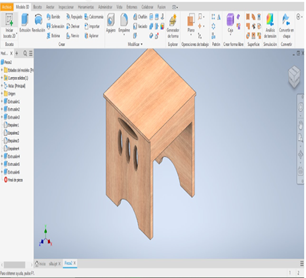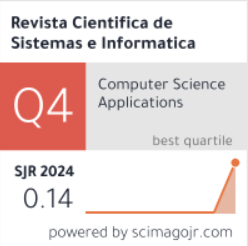Integración de herramientas de manufactura digital en el desarrollo de recursos didácticos ergonómicos: caso de estudio en educación preescolar
DOI:
https://doi.org/10.51252/rcsi.v5i2.973Palabras clave:
aprendizaje infantil, diseño CAD, ergonomía escolar, fabricación asistida computadora, validación pedagógicaResumen
Este estudio abordó la necesidad de mejorar las condiciones ergonómicas del mobiliario escolar en la educación inicial, considerando su impacto en la postura, seguridad y concentración de los niños. El objetivo fue diseñar, fabricar y validar un módulo educativo ergonómico (mesa y silla) para estudiantes de 3 a 5 años, utilizando herramientas de manufactura digital. Se aplicó un enfoque experimental con cinco fases: recolección de datos antropométricos, modelado CAD, manufactura asistida por computadora (CAM), ensamblaje técnico y validación estructural, ergonómica y pedagógica. El diseño consideró normativas internacionales (ISO 5970, UNE-EN 1729-2, ISO 7174-1) y lineamientos del MINEDU. Los resultados mostraron una eficiencia de corte del 92 %, tiempos de fabricación promedio de 85 minutos y alta resistencia estructural. La validación con docentes y niños evidenció un 94 % de adecuación postural y niveles altos de satisfacción en ergonomía, seguridad y funcionalidad. Se concluyó que es viable integrar tecnologías de fabricación digital en el desarrollo de mobiliario escolar ergonómico, con potencial de replicabilidad y transferencia a instituciones públicas de educación inicial.
Descargas
Citas
Baba, A., Shahrour, I., & Baba, M. (2024). Indoor Environmental Quality for Comfort Learning Environments: Case Study of Palestinian School Buildings. Buildings, 14(5), 1296. https://doi.org/10.3390/buildings14051296
Budi, Y. E. P., & Sukmono, T. (2023). Effectiveness of CAD-CAM Application for the Development design and implementation of maintenance tools. Jurnal Penelitian Pendidikan IPA, 9(9), 671–680. https://doi.org/10.29303/jppipa.v9i9.4859
Cardon, G., De Clercq, D., De Bourdeaudhuij, I., & Breithecker, D. (2004). Sitting habits in elementary schoolchildren: a traditional versus a “Moving school.” Patient Education and Counseling, 54(2), 133–142. https://doi.org/10.1016/S0738-3991(03)00215-5
Cash, P., Daalhuizen, J., & Hekkert, P. (2023). Evaluating the efficacy and effectiveness of design methods: A systematic review and assessment framework. Design Studies, 88, 101204. https://doi.org/10.1016/j.destud.2023.101204
Chen, H.-F., & Tsai, C.-Y. (2024). The Impact of School Classroom Chair Depth and Height on Learning Tasks. Education Sciences, 14(6), 661. https://doi.org/10.3390/educsci14060661
Dehghan, S., Sattarpanah Karganroudi, S., Echchakoui, S., & Barka, N. (2025). The Integration of Additive Manufacturing into Industry 4.0 and Industry 5.0: A Bibliometric Analysis (Trends, Opportunities, and Challenges). Machines, 13(1), 62. https://doi.org/10.3390/machines13010062
Esenarro, D., Ccalla, J., Raymundo, V., Castañeda, L., & Davila, S. (2023). Neurostimulating Architecture Applied in the Design of Educational Centers and Early Cognitive Development in the District of Villa El Salvador, Lima. Buildings, 13(12), 3034. https://doi.org/10.3390/buildings13123034
Fazeli, H. R., & Peng, Q. (2022). Generation and evaluation of product concepts by integrating extended axiomatic design, quality function deployment and design structure matrix. Advanced Engineering Informatics, 54, 101716. https://doi.org/10.1016/j.aei.2022.101716
Gumasing, M. J. J., Cruz, I. S. V. Dela, Piñon, D. A. A., Rebong, H. N. M., & Sahagun, D. L. P. (2023). Ergonomic Factors Affecting the Learning Motivation and Academic Attention of SHS Students in Distance Learning. Sustainability, 15(12), 9202. https://doi.org/10.3390/su15129202
Kalita, H., Zindani, D., & Kumar, K. (2019). Additive Manufacturing. In Additive Manufacturing Technologies From an Optimization Perspective (pp. 41–76). https://doi.org/10.4018/978-1-5225-9167-2.ch003
Kantaros, A., Diegel, O., Piromalis, D., Tsaramirsis, G., Khadidos, A. O., Khadidos, A. O., Khan, F. Q., & Jan, S. (2022). 3D printing: Making an innovative technology widely accessible through makerspaces and outsourced services. Materials Today: Proceedings, 49, 2712–2723. https://doi.org/10.1016/j.matpr.2021.09.074
Kraus, S., Jones, P., Kailer, N., Weinmann, A., Chaparro-Banegas, N., & Roig-Tierno, N. (2021). Digital Transformation: An Overview of the Current State of the Art of Research. Sage Open, 11(3). https://doi.org/10.1177/21582440211047576
MINEDU. (2023). Criterios para el Diseño de Mobiliario Educativo de la Educación Básica Regular. https://www.minedu.gob.pe/p/pdf/rvm-n-019-2023-minedu.pdf
Oyetade, K., Zuva, T., & Harmse, A. (2025). Integrating Industry 4.0 technologies into IT education. Cogent Education, 12(1). https://doi.org/10.1080/2331186X.2025.2479195
Podrekar Loredan, N., Kastelic, K., Burnard, M. D., & Šarabon, N. (2022). Ergonomic evaluation of school furniture in Slovenia: From primary school to university. Work, 73(1), 229–245. https://doi.org/10.3233/WOR-210487
Rafiyya, A., Kraiwanit, T., Limna, P., Sonsuphap, R., Kasrisom, A., & Snongtaweeporn, T. (2024). Early childhood social-emotional development: an impact on a developing country. International Journal of Evaluation and Research in Education (IJERE), 13(5), 3081. https://doi.org/10.11591/ijere.v13i5.29462
Rasu, S. (2023). The Future of 3D Printing in Prototype Development: Minimizing Prototype Costs and Decreasing Validation Timelines. Journal of Engineering and Applied Sciences Technology, 1–4. https://doi.org/10.47363/JEAST/2023(5)E134
Soomro, S. A., Casakin, H., & Georgiev, G. V. (2021). Sustainable Design and Prototyping Using Digital Fabrication Tools for Education. Sustainability, 13(3), 1196. https://doi.org/10.3390/su13031196
Tihinen, M., Pikkarainen, A., & Joutsenvaara, J. (2021). Digital Manufacturing Challenges Education—SmartLab Concept as a Concrete Example in Tackling These Challenges. Future Internet, 13(8), 192. https://doi.org/10.3390/fi13080192
Tofail, S. A. M., Koumoulos, E. P., Bandyopadhyay, A., Bose, S., O’Donoghue, L., & Charitidis, C. (2018). Additive manufacturing: scientific and technological challenges, market uptake and opportunities. Materials Today, 21(1), 22–37. https://doi.org/10.1016/j.mattod.2017.07.001
Yan, B., & Wang, Y. (2024). Evaluating the impact of technological development policy on the high-quality development of the manufacturing industry: Mechanisms and threshold effects. Heliyon, 10(16), e35858. https://doi.org/10.1016/j.heliyon.2024.e35858
Yao, K.-C., Chen, D.-C., Pan, C.-H., & Lin, C.-L. (2024). The Development Trends of Computer Numerical Control (CNC) Machine Tool Technology. Mathematics, 12(13), 1923. https://doi.org/10.3390/math12131923

Descargas
Publicado
Cómo citar
Número
Sección
Licencia
Derechos de autor 2025 Fidel Ramos-Ticlla, Enrique Alejandro Barbachan-Ruales, Richar Palomino-Román, Dany César Carhuavilca-Capcha, Miguel Alejandro Barbachan-Villalobos

Esta obra está bajo una licencia internacional Creative Commons Atribución 4.0.
Los autores retienen sus derechos:
a. Los autores retienen sus derechos de marca y patente, y tambien sobre cualquier proceso o procedimiento descrito en el artículo.
b. Los autores retienen el derecho de compartir, copiar, distribuir, ejecutar y comunicar públicamente el articulo publicado en la Revista Científica de Sistemas e Informática (RCSI) (por ejemplo, colocarlo en un repositorio institucional o publicarlo en un libro), con un reconocimiento de su publicación inicial en la RCSI.
c. Los autores retienen el derecho a hacer una posterior publicación de su trabajo, de utilizar el artículo o cualquier parte de aquel (por ejemplo: una compilación de sus trabajos, notas para conferencias, tesis, o para un libro), siempre que indiquen la fuente de publicación (autores del trabajo, revista, volumen, número y fecha).









